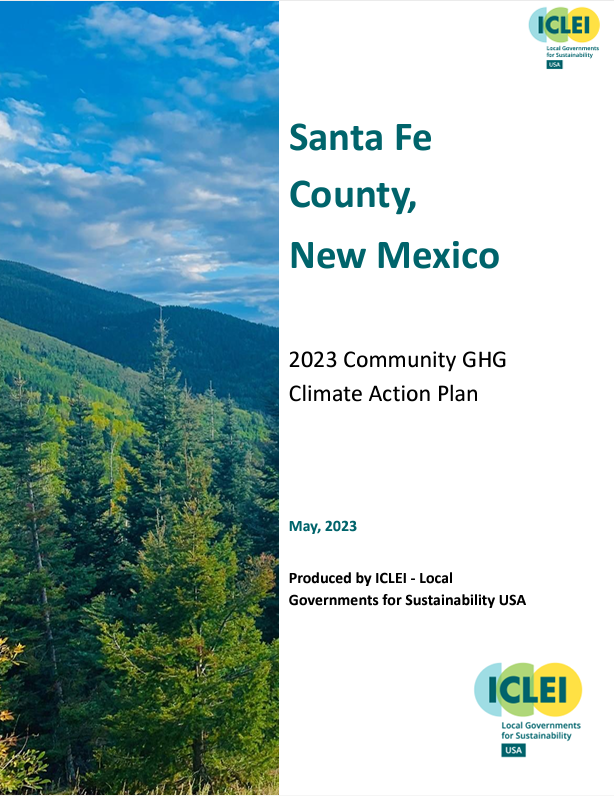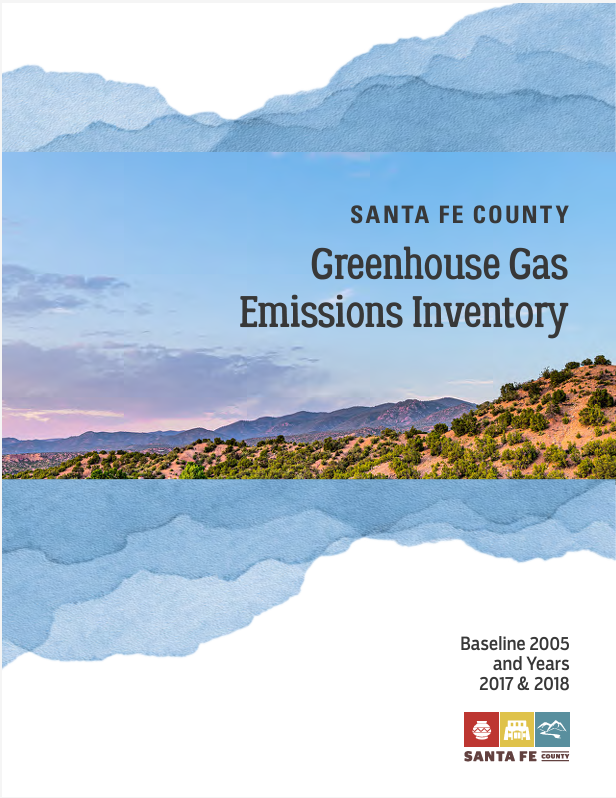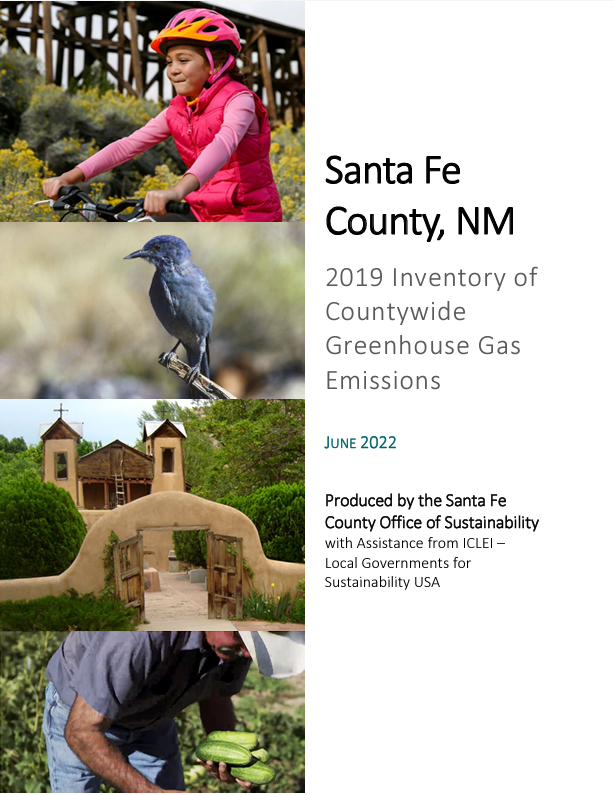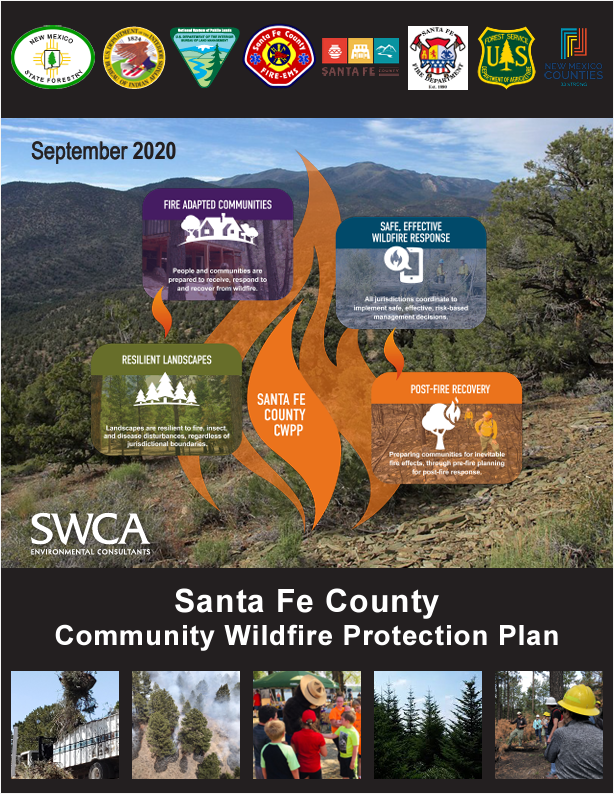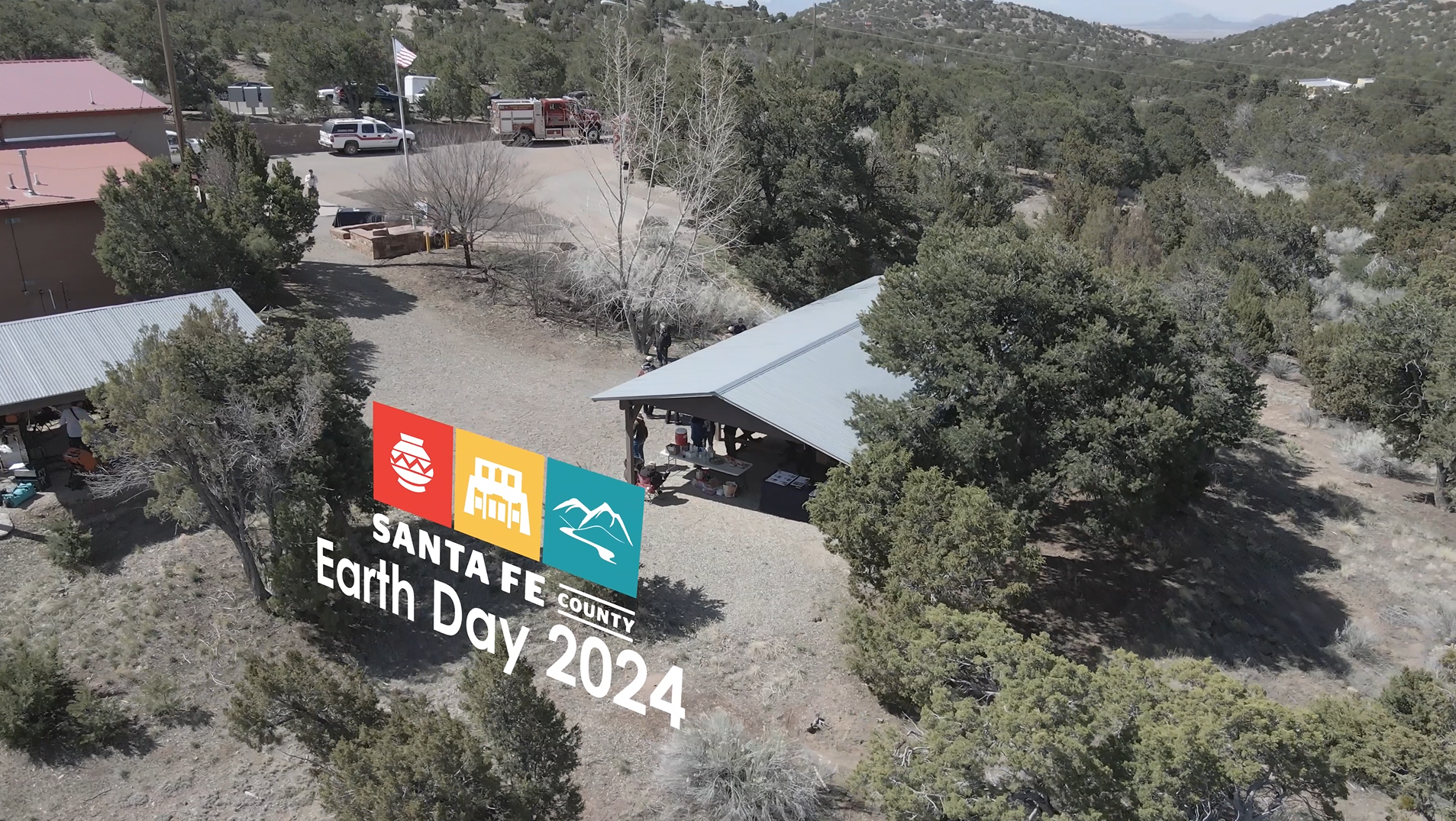![]()
Projects & Programs
Climate Action
Santa Fe County passed Resolution 2023-074 on July 11, 2023 and the Countywide Climate Action Plan Phase I Section 1 and Section 2 in support of the 2015 Paris Agreement and goal to meet Science Based Target (SBT) goals of 54% greenhourse gas emissions reduction by 2030 and 100% by 2050.
Santa Fe County is committed to reaching net-zero greenhouse gas (GHG) emissions by 2050. As the first step towards that goal, the County developed GHG emission inventories of County operations for 2005, 2017, and 2018 across several sectors.
GHG Inventory highlights
- Emissions from County operations decreased by 97% from 2005 to 2018, primarily due to the development of a methane gas collection and flaring system at the Caja Del Rio landfill.
- County buildings and facilities are now the greatest contributors to County emissions, producing 55% of GHG emissions in 2018.
- At the time of publication of the report, 1.6 MW of solar had been installed on County facilities to help offset these emissions, with more being installed every year.
Read the full inventory report | view the data dashboard.
This data was used to prepare the County's Greenhouse Gas Emissions Reduction Plan, adopted in 2022. Click here to read the plan.
Race to Zero
In April 2021, Santa Fe County joined the Race to Zero, pledging to reduce emissions from County buildings by 60% by 2025 through renewable energy and energy efficiency upgrades, and to achieve that same goal in buildings across the community by 2030. Key to success is to ensure that all new County facilities are built to specific sustainable performance design standards, detailed in the Sustainability Division's Healthy Buildings Checklist.
Countywide Greenhouse Gas Emissions Inventory
In June 2022, Santa Fe County completed its Countywide Greenhouse Gas Emissions Inventory. This inventory documents emissions from residential, commercial, and industrial energy use; transportation fuel use; solid waste management; water and wastewater management; fugitive emissions from natural gas distribution; and agriculture and forest disturbances. Emissions were quantified for 2019, before the pandemic altered local travel and activities. This inventory will help to inform the County’s climate action plan to mitigate the effects of climate change, increase community resiliency, and enhance social equity. Click here to read the full report.
Countywide Inventory Highlights
- The transportation sector made up 46% of countywide emissions. Within this sector, gasoline-powered vehicles were the largest source of emissions, responsible for 29% of all inventoried emissions in the County. High transportation emissions are intertwined with land use and access to public transportation, walking paths, and biking trails. It is also entangled with high housing costs, which force workers to commute long distances. Nearly 40% of workers commute from outside Santa Fe County, with 22% commuting more than 50 miles. Collaborative land use planning is needed to create places where people can live and work without heavy reliance on a vehicles. Strategies to achieve this include higher density development, investing in equitable transportation infrastructure for all modes of transportation (including biking, walking, and transit), and addressing the rising cost of living.
- Residential and commercial buildings made up 25% and 17% of emissions in the County respectively. The County has committed to reducing emissions from buildings countywide by 60% by 2030 as part of its Race to Zero pledge. Expanding access to renewable energy and energy efficiency upgrades will be key in reaching this goal.
Countywide Greenhouse Gas Emissions by Sector in 2019
Nature & Land
Santa Fe County Commissioners voted to officially support the 30x30 initiative in December 2020. A worldwide, science-based, conservation plan, the 30x30 initiative aims to conserve and restore at least 30% of the Earth’s land, rivers, streams, and oceans by 2030 to protect biodiversity and curb climate change.
The County is doing its part by restoring the landscape falling under its management, including County open space, trails, parks, and facility grounds.
During fiscal year 2021, the County conserved 12 acres of land and planted nearly 1,500 trees and shrubs with the help of over 150 volunteers. Many other organizations throughout the County are also working hard to restore and conserve our land and water!
View Santa Fe County's Fiscal Year 2022 Progress Report
View our Annual Earth Day Storymaps:
2024 | 2023 | 2022 | 2021
Solarize Santa Fe
Santa Fe County is proud to be doing its share to be a part of the global transition to renewable energy. The electricity associated with County operations is on track to be well over 50% renewable by 2025, in line with the 2045 date of New Mexico's Energy Transition Act. Santa Fe County now has 28 facilities that are equipped with solar panels with a combined production of 2.1 megawatts:
- Buckman Direct Diversion Water Treatment Plant (County’s 50% share is 500 kW)
- Buckman Direct Diversion Booster Station 2A (County’s 50% share 750 kW)
- Steven Herrera Judicial Complex (113 kW)
- Tesuque Fire Station #1 (6.1 kW)
- Chimayo Fire Station #1 (4.1 kW)
- Pojoaque Fire Station #1 (8.1 kW)
- Turquoise Trail Fire Station #1 (7.8 kW)
- Arroyo Hondo Fire Station #2 (10.1 kW)
- Agua Fria Fire Station #2 in La Tierra (8.8 kW)
- Edgewood Fire Station #1 (31.9 kW)
- Nancy Rodriguez Community Center (12 kW)
- Nambe Solid Waste Convenience Center (1.34 kW)
- County Administration Building at 100 Catron Street (15 kW)
- Adam/Coll Senior and Community Center in Eldorado (71 kW)
- Agua Fria Fire Station #1 (15 kW)
- Fairground Exhibition Hall (15 kW)
- La Cienega Regional Fire Station at 37 Rancho Viejo Blvd. (63 kW)
- Public Safety Complex (135 kW)
- State Health Building (54.1 kW)
- Vista Grande Library (14.5 kW)
- Bennie Chavez Senior Center (13.2 kW)
- Esperanza Shelter (33.5 kW)
- Edgewood Senior Center (33.9 kW)
- San Marcos Solid Waste Convenience Center (6 kW)
- Tesuque Solid Waste Convenience Center (3.3 kW)
- La Familia Medical Center (60.1 kW)
- Public Works Complex (50 kW)
The PV systems produce over 3 million kWh of energy annually[1], which is equivalent to the CO2 emissions from 4.6 million miles driven by a passenger car, or the amount of carbon sequestered by 1,821 acres of U.S. forests in one year[2]. This renewable energy powers services such as fire stations, senior centers, community centers, and provides clean drinking water.
In 2022 alone, the County's PV systems saved residents over $300,000[3]. Moreover, these systems reduce approximately 2,129 tons of greenhouse gas emissions each year[4], improving air quality in New Mexico and increasing the County's climate resiliency.
___________________________________________________________________________________________________________________________________________________________________________________________________________________
[1] Estimated using PV production data, NREL PVWatts Tool and assumption of 4.1 kWh/kW/day.
[2] Calculated using 2021 NM EPA eGRID data and the EPA Greenhouse Gas Equivalencies Calculator.
[3] Estimated kWh production data and average price per kWh.
[4] Estimated using 2019 AVERT U.S national weighted average C02 marginal emission rate.
Sustainability Awards
2020 - SolSmart Bronze
2020 - PNM Business Energy Efficiency Star Award for New Construction
2023 - "Best Medium-sized Energy Efficiency and Water Conservation Project"
2023 - CDP Grade A - Global Leader for Climate Action

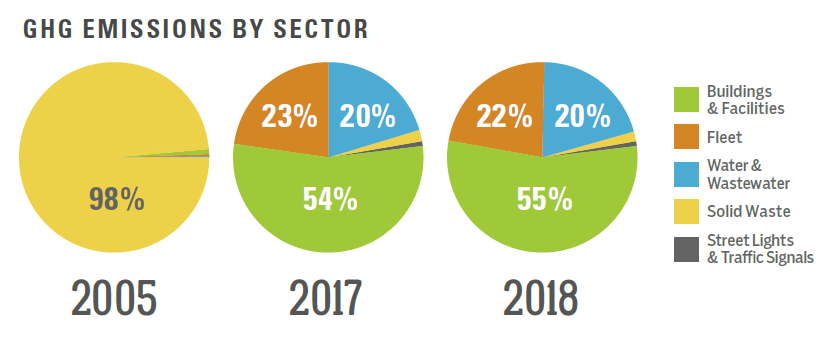
.PNG)
